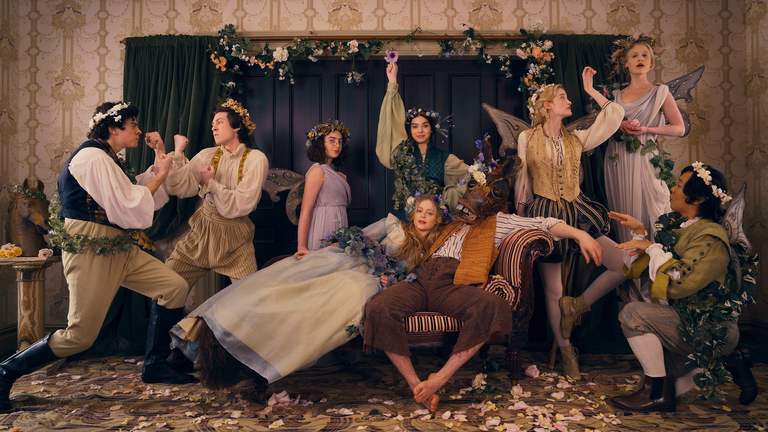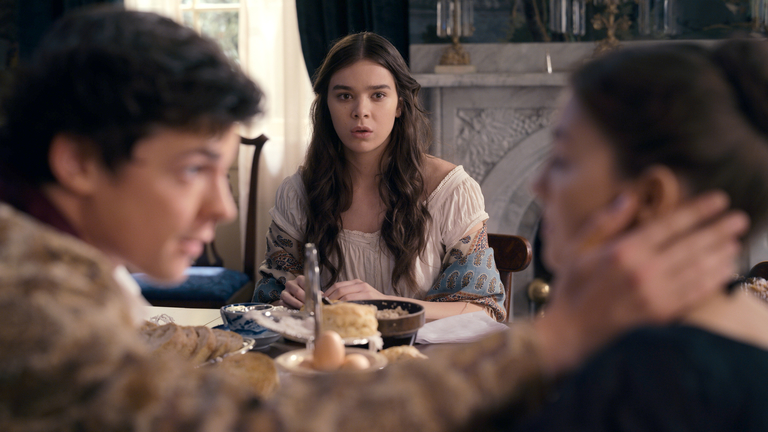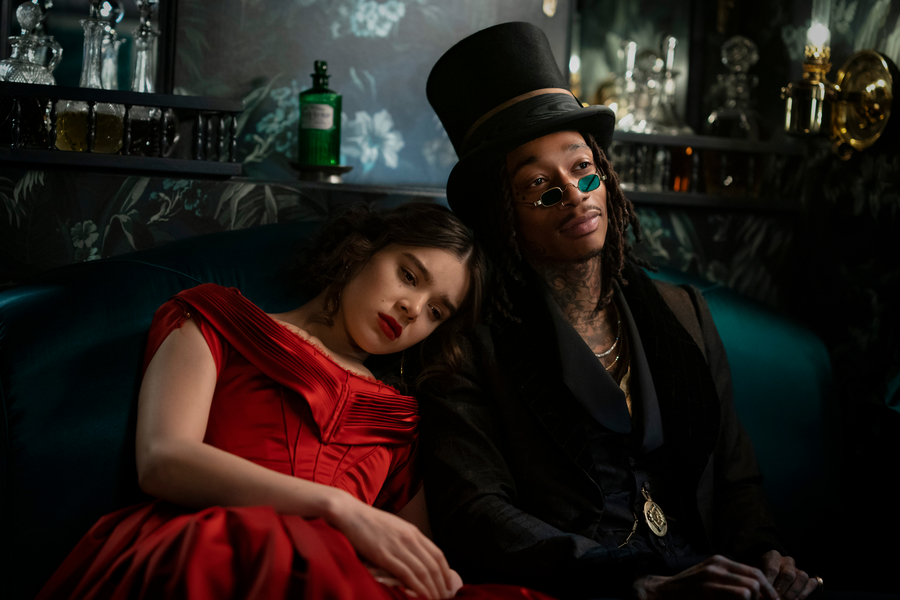I’ll be the first to admit that when I heard Apple was coming out with their own original programming and television subscription package I rolled my eyes.
Just another thing to spend money on, I said. I’ll pass, I said.
But, then they debuted the Dickinson trailer, and I was already beginning to renege on my promise to myself that I wouldn’t be adding anything to the recurring payments section of my budget.
Rarely do movies and television shows live up to the hype of a well-edited trailer, but consider Dickinson as one that lives up to and overcomes the expectations of the bombastic trailer.
With intriguing lures like Wiz Khalifa as Death personified and Hailee Steinfeld as the eponymous Emily Dickinson, this black comedy series created by Alena Smith is instantly addictive. With ten short episodes coming in at half an hour each, the period setting is displaced by the modern tone and sensibilities.
Emily Dickinson has often been woefully misinterpreted as a sad old spinster who wrote depressing and macabre poems while living with her brother and his wife. However, Dickinson erases all notions of that and replaces it with a young, lively, energetic young woman coming to age in a world that tells her the only value in her life is to marry and become a homemaker.
While the series does stumble a few times, storytelling around topics like race and sexuality, it stands firm when it comes to the characterization of Emily. She is a headstrong and creative woman, whose eccentricities designate her as the town weirdo. As the series progresses, the nuanced layers to Emily’s character are only further highlighted by Steinfeld’s stellar performance.
It’s completely fair to say that Emily suffered some oppression as a woman in her society, however the story is quick to shed light on just how privileged the young woman was.

Daughter of a well-off notable lawyer (Toby Huss) in town, Emily is obviously her father’s favorite child. Despite his repeated disdain for her ambitions as a writer, he appeases her, allowing pursue at her passion. Her daily routine is characterized by lounging around her room, lying under the oak tree planted by her grandfather, scribbling on scraps of paper deep into the night, and shirking the household chores set by her mother (Jane Krakowski).
While her main struggle in life is avoiding the matchmaking sessions set by her mother, her difficulties pale in comparison to the characters outside her society.
There are vague commentaries about the issues of the times, like class inequality, slavery, the oncoming civil war, and immigration. However, rarely are they in service of the actual issues, rather used to highlight Emily’s own privileges in life. It’s these privileges that make even Emily and her family’s most well-intentioned actions feel ham-fisted and cringe-worthy at times.
It might be understandable that a teenage Emily is oblivious to race relations and immigration, having grown up in a sheltered upper-middle-class New England home where she is spoiled and given everything she wants. To this, the series showcases Sue Gilbert (Ella Hunt), Emily’s best friend, future sister-in-law, and lover, as a foil.
Yes, you heard right. Future sister-in-law/Lover.
The series does not shy away from the rumor that Emily Dickinson was a lesbian and actually in love with her brother’s (Adrian Enscoe) fiancee. Instead, it leans fully into the idea. Given how many poems the real Emily wrote dedicated to Sue, it’s a fair deduction to make.
The series paints Sue as a soft-spoken, constantly-mourning, penniless orphan. Where Emily gets her father to hire a maid because she wants more time to write, Sue is forced to go to Boston to work as a governess to earn a living wage (and offhandedly gets raped?) It casts a rather insulting light on a historical figure who was often characterized as vivacious and charismatic as the fictional Emily.
The real Susan Huntington Gilbert was not penniless (she had a generous dowry when she married Austin) or without family (her parents did died, but she was the youngest of seven). She was a poet, herself, a mathematician, and described by her contemporaries as the “most graceful woman in Western Massachusetts”. While the series gets Sue and Emily’s closely tied relationship right, the fictionalized version is in much more need of help than the historical one is.

Of course, this love triangle between Emily, Austin, and Sue feels a little short-lived in the scope of the series. Although creator Alena Smith describes Sue as Emily’s soul mate, we are introduced to Ben Newton (Matt Lauria, from the woefully underappreciated Kingdom series) halfway through the season, and Emily’s romantic life takes a decidedly hetero turn.
This is not to say that there isn’t the potential for a bisexual Emily Dickinson. If anything, the finale redeems the aspects of sexual fluidity in both Ben and Emily that seemed missing in the back half of the season. But, with the disappearance of Sue to Boston and the lack of scenes between Sue and Emily, it feels as if Emily has simply moved on from her “soul mate”.
Thankfully, this feels more like a problem with the timing of the episodes. After Ben’s tragic passing, the series culminates in the chaotic wedding day of Austin and Sue that leave everyone in a period of disarray.
Despite my gripes about the show here, Dickinson is actually delightfully refreshing and addictively enjoyable. I watched the entire series in the span of a day, setting aside obligations and chores like Emily on a frenzied day struck by inspiration.
One of the true gems of the series was the casting. Despite my initial reservations about Hailee Steinfeld in the role, I was quickly reminded of her acting chops as she took on this iconic role that blended the audaciousness of youth with the trimmings of periodic drama.
Surprisingly, Emily’s sister Lavinia (Anna Baryshnikov) was one of my favorite characters. Her quiet growth from boy crazy little sister to the scorned woman to empowered artist was one of the more gratifying side plots.
My praise goes to the rest of the cast as well. Huss and Krakowski embody their roles perfectly as struggling parents and adults also fumbling to find where they belong. While Enscoe, Hunt, and Baryshnikov hold their own playing against Steinfeld’s foolproof performance. And, again, I just want to say how much I enjoyed Matt Lauria as Ben Newton. Kingdom was one of the most underappreciated shows, and it’s so great to see Lauria back on my screen, especially as the amiable Ben Newton (who historically did have a strong impact on Emily Dickinson.)

Additionally, guest roles by John Mulaney, Jason Mantzoukas, and Wiz Khalifa added an extra dosage of flavor and modern quirk. Mulaney’s Henry David Thoreau is hilariously played as a fame-hungry manchild who lives on his parents’ land, has his laundry done by his mom, and has cookies delivered by his sister. Mantzoukas voices the bizarre and cartoonish life-sized bee that appears to Emily in her hallucinations. Even in bee form, Jason Mantzoukas is hilarious.
And of course, there is Wiz as Death. Let me just say, all flaws aside, this was an actual revelation. Oozing cool and dripping in macabre charm, Dickinson‘s Death is stylish, smooth-talking, flirtatious, and mesmerizing to watch. Given how often Emily’s writing personified death, giving death the physical form of an attractive and mysterious man that whisks Emily away in his ghost-horse-drawn carriage is a stroke of genius.
Dickinson is imperfect but captures the spirit of being young in a coming-of-age story that is delivered in a tone that is relatable to a younger audience. It’s more than worth the price tag of the AppleTV+ subscription and I’ll welcome a second season because you can never really have too much of Emily Dickinson.